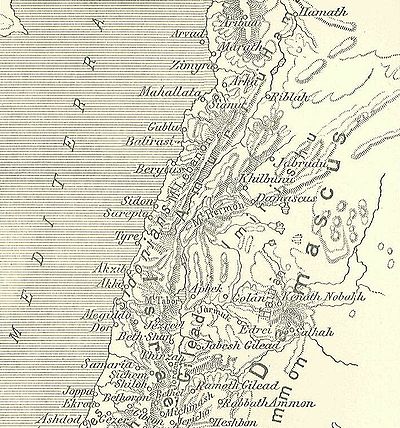
Naziba
Encyclopedia

City-state
A city-state is an independent or autonomous entity whose territory consists of a city which is not administered as a part of another local government.-Historical city-states:...
' south of Dimašqu-(Damascus
Damascus
Damascus , commonly known in Syria as Al Sham , and as the City of Jasmine , is the capital and the second largest city of Syria after Aleppo, both are part of the country's 14 governorates. In addition to being one of the oldest continuously inhabited cities in the world, Damascus is a major...
), in the 1350-1335 BC Amarna letters
Amarna letters
The Amarna letters are an archive of correspondence on clay tablets, mostly diplomatic, between the Egyptian administration and its representatives in Canaan and Amurru during the New Kingdom...
correspondence
Text corpus
In linguistics, a corpus or text corpus is a large and structured set of texts...
. The town of Naziba was located near Amarna letters Qanu, now named Qanawat, and biblical Kenath.
Naziba, is part of a 6-letter series of letters, written by the same scribe
Scribe
A scribe is a person who writes books or documents by hand as a profession and helps the city keep track of its records. The profession, previously found in all literate cultures in some form, lost most of its importance and status with the advent of printing...
, all entitled: "Ready for marching orders (1-6)". The letters are mostly identical, with only the city's Ruler and the location changing; they are letters EA 201-EA 206, (EA for 'el Amarna
Amarna
Amarna is an extensive Egyptian archaeological site that represents the remains of the capital city newly–established and built by the Pharaoh Akhenaten of the late Eighteenth Dynasty , and abandoned shortly afterwards...
').
EA 206, for the "ruler of Naziba"
- "Say to the king, my lord: Message of the ruler of Naziba, your servant. I fall at the feetProstration formulaIn the 1350 BC correspondence of 382–letters, called the Amarna letters, the Prostration formula is usually the opening subservient remarks to the addressee, the Egyptian pharaoh. The formula is based on Prostration, namely reverence and submissiveness...
of the king, my lord, 7 times plus 7 times. You hav[e wr]it[ten] to make preparations before the arrival of the archersArchers (Egyptian pítati)The Pítati were a contingent of archers in the Egyptian Empire, often requested and dispatched, to support the Egyptian vassalage in Canaan, or northern Canaan...
, and I am herewith, along with my troops and my chariotChariotThe chariot is a type of horse carriage used in both peace and war as the chief vehicle of many ancient peoples. Ox carts, proto-chariots, were built by the Proto-Indo-Europeans and also built in Mesopotamia as early as 3000 BC. The original horse chariot was a fast, light, open, two wheeled...
s, at the disposition of the archers." -EA 206, lines 1-17 (complete)
List of the 6-letter series
-
- EA 201-marching orders (1)—for Artamanya of Siribašani
- EA 202-marching orders (2)—for Amawaše of Bašan(?)
- EA 203-marching orders (3)—for 'Abdi-Milki of ŠashimiSashimiSashimi is a Japanese delicacy. It consists of very fresh raw meat, most commonly fish, sliced into thin pieces.-Origin:The word sashimi means "pierced body", i.e...
- EA 204-marching orders (4)—for the 'ruler' of Qanu, called Qanawat
- EA 205-marching orders (5)—for the 'ruler' of Tubu (town)Tubu (town)Tubu is the town east of the Sea of Galilee referred to in the of the Amarna letters.Tubu is the probable biblical town of Tob. In the entire group of El Amarna letters, EA 205 is the only usage of the name Tubu, and only the "Man" is referenced.The scribe who wrote EA 205, visited and /or wrote...
- EA 206-marching orders (6)—for the 'ruler' of Naziba
- Additional by scribe: EA 195—title: "Waiting for the PharaohPharaohPharaoh is a title used in many modern discussions of the ancient Egyptian rulers of all periods. The title originates in the term "pr-aa" which means "great house" and describes the royal palace...
's words"–by BiryawazaBiryawazaBiryawaza was king of Damascus in the middle fourteenth century BC. In the Amarna letters, he was ordered by his Egyptian overlords to take armed action against Labaya's sons ....
of Dimašqu-DamascusDamascusDamascus , commonly known in Syria as Al Sham , and as the City of Jasmine , is the capital and the second largest city of Syria after Aleppo, both are part of the country's 14 governorates. In addition to being one of the oldest continuously inhabited cities in the world, Damascus is a major...
See also
- Tubu (town)Tubu (town)Tubu is the town east of the Sea of Galilee referred to in the of the Amarna letters.Tubu is the probable biblical town of Tob. In the entire group of El Amarna letters, EA 205 is the only usage of the name Tubu, and only the "Man" is referenced.The scribe who wrote EA 205, visited and /or wrote...
, for the "ruler of Tubu" - Qanawat-(Qanu)
- Amarna lettersAmarna lettersThe Amarna letters are an archive of correspondence on clay tablets, mostly diplomatic, between the Egyptian administration and its representatives in Canaan and Amurru during the New Kingdom...
- Amarna letters–localities and their rulersAmarna letters–localities and their rulersThis is a list of the "Amarna letters" –Text corpus, categorized by: Amarna letters–localities and their rulers. It includes countries, regions, and the cities/or 'city-states' ...

